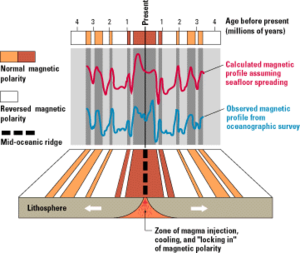Frederick Vine facts for kids
Quick facts for kids
Frederick Vine
|
|
|---|---|

Frederick Vine (right) and Drummond Matthews, 1981
|
|
| Born | 17 June 1939 Chiswick, London, United Kingdom
|
| Nationality | British |
| Education | Latymer Upper School |
| Alma mater | St John's College, Cambridge |
| Spouse(s) | Susan 'Sue' Vine (née McCall) |
| Awards | Arthur L. Day Medal (1968) Bigsby Medal (1971) Chapman Medal (1973) FRS (1974) Appleton Medal and Prize (1977) Balzan Prize (1981) Hughes Medal (1982) Prestwich Medal (2007) |
| Scientific career | |
| Fields | Marine Geologist Geophysicist |
| Institutions | Princeton University University of East Anglia |
Frederick John Vine, born on June 17, 1939, is a British scientist. He is a marine geologist, studying the ocean floor, and a geophysicist, studying Earth's physical processes.
Vine made very important discoveries about plate tectonics. This is the idea that Earth's outer layer is made of large moving plates. He helped show that the seafloor spreads apart. This happens at mid-ocean ridges, which are underwater mountain ranges. He found a special pattern of magnetic reversals in the rocks on either side of these ridges.
Contents
Early Life and Education
Frederick Vine was born in Chiswick, London, England. He went to Latymer Upper School for his early education. Later, he studied at St John's College, Cambridge University. There, he earned a degree in Natural Sciences in 1962. He then focused on marine geophysics for his PhD, which he finished in 1965.
He married Susan 'Sue' Vine, who was also a research assistant. She worked with Drummond Matthews at Cambridge University. She helped develop the idea of seafloor spreading with her husband and Matthews.
Understanding Plate Tectonics
Frederick Vine's PhD research was about 'Magnetism in the Seafloor'. His supervisor was Drummond Matthews. Vine learned about sea floor spreading from scientist Harry Hess. This idea suggests the ocean floor acts like a "conveyor belt," slowly moving away from central ridges.
Vine's work, along with Drummond Matthews and Lawrence Morley, was very important. They helped explain the magnetic patterns found in the ocean crust. This explanation is now called the Vine–Matthews–Morley hypothesis. They supported the idea that seafloor spreading happens at mid-ocean ridges.
Vine and Matthews showed that new basalt rock formed at a mid-ocean ridge records Earth's magnetic field. This means the ocean floor acts like a "tape recorder" for Earth's magnetic history. They also showed that magnetic reversals are "frozen" into these rocks. These reversals appear as parallel stripes on the seafloor. You can see these stripes when you move away from the ridge crest.
Academic Career and Research
Frederick Vine worked on several interesting projects. He studied Ophiolite rocks in the Troodos mountains of southern Cyprus. These rocks are pieces of oceanic crust that have been pushed onto land.
He also researched the history of Earth's magnetic field. Later, he studied how well rocks from deep inside Earth conduct electricity. This research helped scientists understand more about Earth's lower crust.
In 1967, Vine became a professor at Princeton University in the United States. In 1970, he moved to the University of East Anglia in England. He became a full professor there in 1974. He also served as the "dean" (a leader) of his department twice. After 1998, he continued his work as a special professor. In 2008, he became an emeritus professor, meaning he retired but kept his title.
Awards and Honours
Frederick Vine has received many important awards for his scientific work. These include:
- The Arthur L. Day Medal in 1968
- The Bigelow Medal in 1970
- The Bigsby Medal in 1971
- The Chapman Medal in 1973
- Becoming a Fellow of the Royal Society in 1974. This is a very high honour for scientists in the UK.
- The The Chree Medal and Prize in 1977
- The International Balzan Prize in 1981
- The Hughes Medal in 1982
- The Prestwich Medal in 2007
See also
- List of geophysicists


